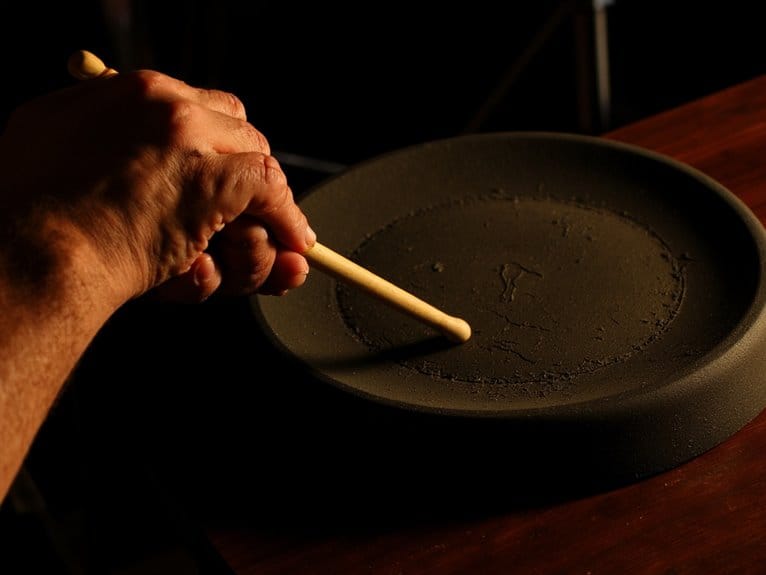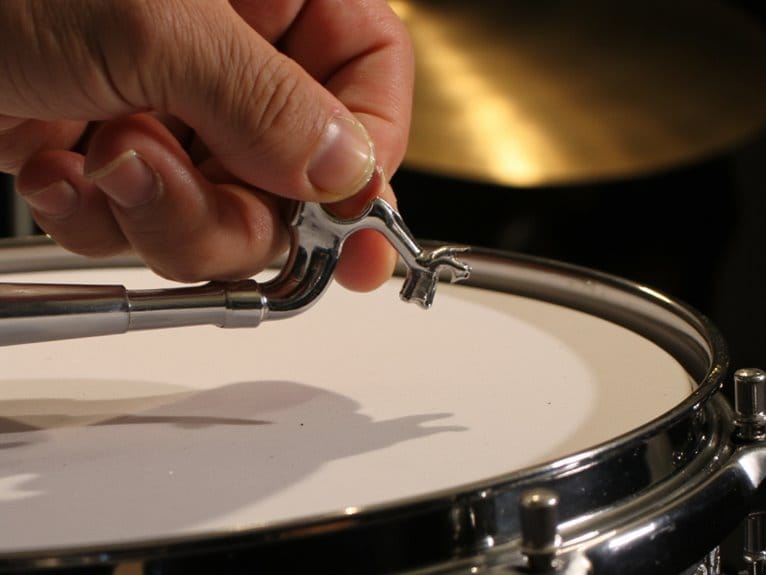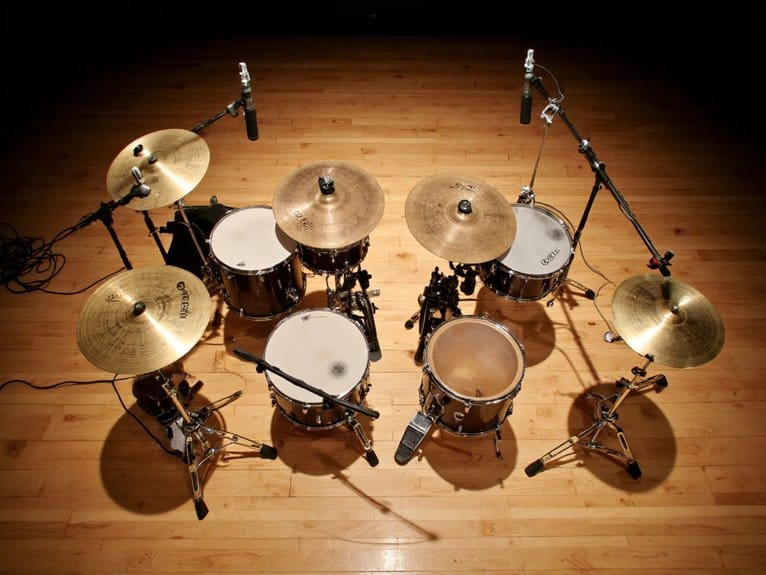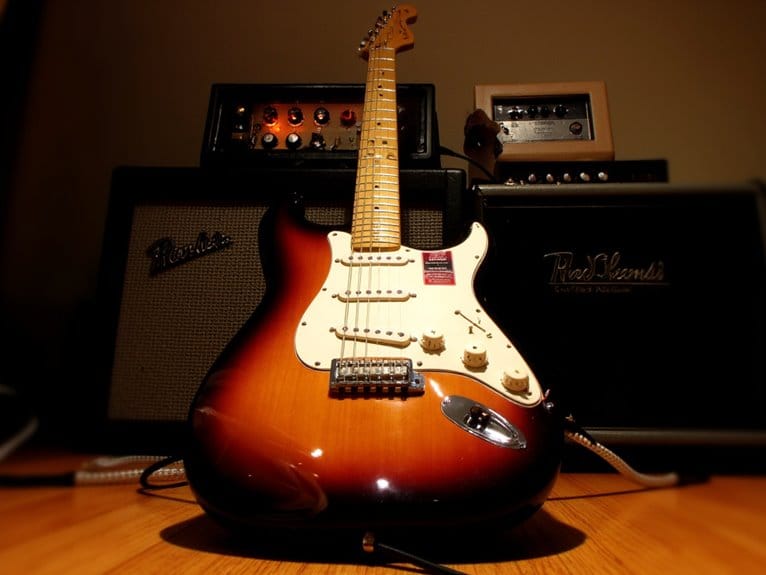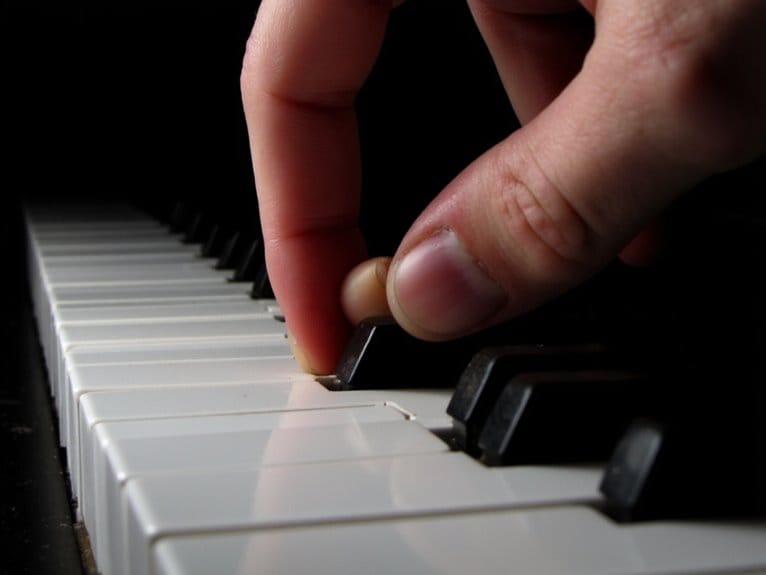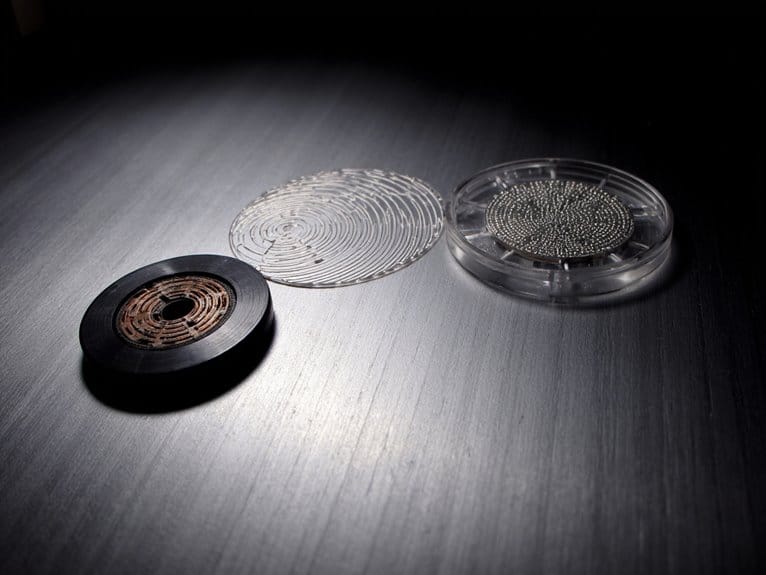Practice Pad Training: Building Chops Quietly
You’ll develop exceptional stick control and muscle memory through practice pad training, which eliminates distractions while building the foundational technique that separates good drummers from great ones. High-density rubber pads require more muscle control than acoustic kits, creating natural resistance training that builds endurance for extended sessions. Modern MIDI-enabled pads offer velocity-sensitive surfaces and Bluetooth connectivity, letting you practice rimshots, cross-sticks, and complex rudiments at any hour without disturbing neighbors. Discover the specific techniques that maximize your silent practice sessions.
We are supported by our audience. When you purchase through links on our site, we may earn an affiliate commission, at no extra cost for you. Learn more.
Notable Insights
- Silent practice pads eliminate noise distractions, enabling focused technique development at any hour without disturbing others.
- High-density rubber pads require more muscle control than acoustic drums, building superior endurance and stick control fundamentals.
- Consistent daily practice on pads develops muscle memory through controlled repetitions at varied tempos and stroke heights.
- Modern MIDI-enabled pads offer velocity sensitivity and digital connectivity for interactive lessons and precise timing development.
- Lightweight, portable design allows spontaneous practice sessions anywhere, fitting easily in backpacks for travel convenience.
Silent Practice Sessions for Better Focus
While I’ve spent countless hours in noisy practice rooms over the years, I’ve discovered that some of my most productive sessions actually happen in complete silence, where the absence of sound forces you to develop an entirely different relationship with your instrument.
Silent immersion transforms your practice routine by eliminating external distractions that typically fragment your attention, allowing you to focus intensely on stick placement, timing precision, and muscle memory development.
When distractions fade away, your hands discover precision they never knew existed in the noise.
This focused mindfulness approach helps you tune into breathing patterns, posture alignment, and tension points that often go unnoticed during loud sessions. The therapeutic effects of this practice extend beyond technical improvement, creating a calming environment that reduces performance anxiety and promotes overall well-being.
You’ll find yourself moving more deliberately, processing technical details with greater accuracy, and building internal rhythm awareness that translates directly to improved performance when you return to full-volume playing. High-quality practice pads with high-density rubber surfaces provide the authentic snare drum rebound that makes this silent training so effective for skill development. Without the distraction of sound, your workout duration naturally decreases as efficiency improves and unnecessary repetitions are eliminated.
Developing Precision and Hand Technique
You’ll find that mastering stick control fundamentals on your practice pad creates the foundation for everything else you’ll accomplish behind a kit, since proper finger technique and rebound control directly translate to cleaner fills, more consistent grooves, and reduced fatigue during longer playing sessions.
When you focus on developing muscle memory through repetitive exercises, your hands learn to execute complex patterns automatically, which frees up your mental bandwidth to concentrate on musical expression rather than mechanical execution. Starting with gradual speed increments from comfortable tempos like 60 bpm and progressively challenging yourself to faster speeds builds both confidence and control more effectively than jumping immediately to advanced speeds.
I’ve noticed that drummers who skip this foundational work often plateau quickly, struggling with timing inconsistencies and uneven dynamics that could’ve been prevented through dedicated pad practice focusing on precision over speed. For apartment dwellers or those in shared spaces, practice pads offer the advantage of operating at noise levels well below what acoustic drums produce, allowing for consistent daily practice without disturbing neighbors. Many drummers complement their pad work with affordable drum machines that feature dynamic articulation, responding to playing intensity to create more natural and expressive practice sessions. Since proper tuning requires frequent adjustments during practice, having universal compatibility drum keys ensures you can make quick micro-adjustments to maintain optimal sound quality across different drum configurations.
Stick Control Fundamentals
Before you can master complex drumming techniques, developing proper stick control fundamentals forms the essential foundation that’ll determine your precision, speed, and overall musical expression throughout your drumming journey.
Your stick grip should create that “A-OK” shape between thumb and index finger, holding loosely enough to let the stick balance at its natural pivot point while maintaining control.
Proper wrist technique emphasizes fluid movement as your primary stroke generator, with fingers acting as fine-tuners for rebound control and dynamic adjustments.
I’ve found that practicing controlled rebounds at different stroke heights—full, half, and low—builds the muscle memory you’ll need for consistent sound quality, while maintaining relaxed muscles prevents the tension buildup that’ll sabotage your endurance during longer practice sessions.
A quality drum rug beneath your practice setup provides essential stability and prevents your pad from sliding during intense training sessions, ensuring consistent positioning for muscle memory development.
Quality shock mounts are necessary to eliminate vibration interference when you transition from practice pad work to recording sessions with acoustic drums.
When recording your practice sessions for analysis, wireless lavalier mics positioned near your practice setup capture the subtle nuances of stick control that help you identify areas needing improvement.
Muscle Memory Development
The journey toward developing rock-solid muscle memory happens in three distinct phases—learning, rehearsal, and perfecting—each requiring a different approach to practice that’ll transform mechanical movements into natural, expressive drumming.
During the learning phase, you’ll focus on slow, deliberate repetitions that allow your brain to properly encode the basic motor patterns without rushing through mistakes.
The rehearsal stage involves consistent daily practice where these rhythmic patterns become more fluid, and I’ve found that varying tempos and dynamics during this phase greatly accelerates muscle encoding.
Finally, the perfecting phase integrates mindful focus with technical precision, making complex patterns feel as automatic as speaking.
For drummers looking to enhance their practice sessions further, incorporating velocity-sensitive pads can capture the subtle dynamic variations essential for developing proper touch and articulation.
Building Muscular Endurance and Strength
While most drummers focus on learning complex fills and flashy techniques, I’ve discovered that building muscular endurance and strength forms the foundation that separates weekend warriors from serious players.
Practice pads demand considerably more muscle control than acoustic kits due to their reduced rebound characteristics, forcing your hands and forearms to work harder with every stroke. This resistance creates an ideal endurance training environment that strengthens the specific muscles you’ll use during extended playing sessions.
Through consistent pad work, you’ll develop the stamina needed for those marathon gigs where your chops matter most:
- Progressive overload through longer practice sessions builds foundational strength
- Controlled stick rebound management increases muscular engagement
- Varied rudiments target different muscle groups for balanced development
- Periodized training prevents fatigue while maximizing strength gains
Similar to how musicians choose instruments based on body materials that affect performance characteristics, practice pad selection impacts the effectiveness of your training routine. Just as drummers benefit from proper seating with ergonomic elements like thigh cutouts and backrests to minimize discomfort during long playing sessions, practice pad training builds the muscular foundation needed to maintain technique throughout extended performances. Developing proper muscle memory through pad work also prepares you to handle sound pressure levels exceeding 160 dB when transitioning to live performance environments.
Advanced Features and Surface Options
Modern practice pads have evolved far beyond simple rubber surfaces, now offering sophisticated features that bridge the gap between silent practice and real-world drumming scenarios.
You’ll find options ranging from MIDI-enabled pads that connect to your smartphone or computer for interactive lessons, to dual-zone surfaces that replicate everything from tight snare響 to loose tom feels within a single device.
These advanced pads often include built-in metronomes with multiple subdivision patterns, interchangeable surface materials like silicone and Kevlar-emulation compounds, and even responsive rim zones that let you practice rimshots and cross-stick techniques with surprising authenticity.
MIDI and Digital Connectivity
As practice pads evolve beyond simple surfaces for stick technique, MIDI connectivity and digital connectivity transform these humble training tools into sophisticated musical interfaces that rival full electronic drum kits.
You’ll find USB advantages like direct computer connection eliminate additional hardware while ensuring faster data transfer speeds. Bluetooth integration reduces cable clutter, though I’ve noticed occasional latency issues during intensive practice sessions.
Your digital workflow benefits from velocity-sensitive pads that capture strike intensity, translating subtle dynamics into expressive MIDI data that DAWs can record and edit extensively. Just as output resistance levels affect tonal balance in guitar pickups, the sensitivity calibration of practice pads influences how accurately they translate your playing dynamics into digital format.
- Foot-switch inputs expand authentic playing experiences by connecting bass drum and hi-hat pedals
- Multi-pad audio linking layers multiple samples simultaneously for complex textural arrangements
- Real-time sample loading through dedicated apps minimizes downtime when switching between drum kits
- Customizable settings include LED feedback systems and velocity calibration matching individual playing styles
Many practice pads now feature dual-zone mesh technology that enhances dynamic response and provides superior sound variations compared to traditional rubber surfaces. Professional models often incorporate extensive sound libraries with hundreds of drum sounds and preset kits, offering practice variety that rivals expensive electronic drum systems.
Surface Material Varieties
Five distinct surface materials define the modern practice pad landscape, each engineered to deliver specific tactile responses that’ll transform your stick technique development in measurably different ways.
Traditional gum rubber surfaces on wood bases deliver the classic rebound you’ll recognize from decades of drummer training, while foam rubber conditioning pads absorb stick energy to build your endurance through increased physical effort.
Multi-surface pads feature varied zones that simulate different drum components, from snare responsiveness to cymbal hardness, allowing thorough kit practice on a single pad.
Marching snare pads utilize dense carbon fiber or proprietary rubber blends on laminate bases for high-tension simulation.
Each material choice affects bounce characteristics, noise levels, and muscle development, making surface selection vital for your specific practice goals.
When transitioning to actual drums, understanding how different drumhead materials like Mylar construction and two-ply designs affect stick response will help you adapt your practice pad techniques to various kit configurations.
Integrated Metronome Technology
The integration of sophisticated metronome technology into practice pads represents a quantum leap beyond simple surface material considerations, transforming these training tools into extensive timing laboratories that’ll revolutionize how you develop rhythmic precision.
These advanced systems deliver interactive feedback through multiple sensory channels, measuring your performance with millisecond accuracy while providing real time analysis that’ll expose even the subtlest timing inconsistencies you didn’t know existed.
- Precision Timing Measurement: Interactive Metronome technology tracks your hits to the millisecond, offering immediate audio feedback with distinct tones for early, on-time, or late strikes
- Programmable Complex Rhythms: Advanced apps like PolyNome create intricate percussion grooves including quintuplets and septuplets beyond basic click tracks
- Cloud-Based Progress Tracking: Dedicated software synchronizes training data across devices, enabling long-term performance monitoring and adaptive skill development
- Multi-Modal Sensory Integration: Combined auditory and visual feedback systems enhance learning effectiveness while accommodating different processing preferences
Effective Practice Routines and Methods
When you’re serious about developing your drumming technique, establishing structured practice routines on your pad becomes the foundation that’ll separate casual playing from genuine skill development.
Your warm-up should begin with one-handed eighth notes, progressing through alternating sixteenth notes and double rolls before tackling paradiddles. This silent introspection allows you to focus purely on stroke control without distractions.
Build technical chops using simple rudiment combinations like single paradiddles and specific sticking patterns such as RLRR LRLL, gradually increasing tempo from 60 to 180 bpm.
Incorporate flam tap variations and quintuplet patterns to sharpen coordination between hands. Practice known songs with metronome settings, starting at quarter notes and progressing to downbeat-only timing.
This mindful practice approach develops muscle memory, rebound control, and rhythmic precision through consistent repetition.
Portability and Convenience Benefits
Beyond technique development, practice pads deliver unmatched convenience that transforms how you approach daily drumming practice, particularly when space constraints or noise restrictions threaten to derail your progress.
Practice pads eliminate the spatial and acoustic barriers that traditionally limit when and where drummers can maintain their skill development.
Their lightweight design makes compact transportation effortless, while easy storage eliminates the spatial demands of full drum kits.
You’ll discover remarkable freedom when your practice routine isn’t tethered to a single location or dependent on soundproofing considerations:
- Silent practice sessions at any hour without disturbing neighbors or roommates
- Zero setup requirements – simply place on any flat surface and begin playing immediately
- Travel-friendly dimensions that fit comfortably in backpacks or instrument cases
- Multiple environment compatibility from hotel rooms to office spaces during breaks
This portability encourages consistent skill development regardless of your living situation or schedule constraints.
Professional audio interfaces like RME’s models offer bus-powered designs that similarly prioritize portability while maintaining exceptional performance standards.
For drummers seeking even more versatility, modern electronic drum sets can weigh as little as 1.7 pounds while offering extensive sound libraries and built-in learning tools that enhance practice effectiveness. Some electronic options feature mesh pads that provide responsive dynamics for realistic playability while maintaining the quiet practice benefits essential for apartment living.
Frequently Asked Questions
How Much Should I Spend on a Quality Practice Pad?
You’ll find excellent budget options around $50-$100 for serious practice. Quality comparison shows mid-range pads balance durability and rebound perfectly. Entry-level under $30 works for beginners, while premium exceeds $100.
Can Practice Pad Training Replace Acoustic Drum Lessons Completely?
You can’t replace acoustic drum lessons completely with practice pads. While practice pad benefits include building technique and strength, acoustic drum limitations prevent developing full kit coordination, dynamics, and expressive nuances essential for complete drumming skills.
What’s the Ideal Daily Practice Time on Pads for Beginners?
For daily practice as a beginner, you’ll want to start with 5-15 minutes consistently. These beginner tips emphasize quality over quantity – short, focused sessions beat sporadic long ones. Aim for 20-30 minutes max to avoid fatigue.
Do Practice Pads Work Well for Bass Drum Technique Development?
Practice pads absolutely work for bass drum technique development. You’ll find quality pads simulate realistic pedal rebound effectively. Through pad surface comparison, rubber and composite materials offer excellent bounce responsiveness, helping you build timing, control, and muscle memory efficiently.
How Long Do Practice Pad Surfaces Typically Last With Regular Use?
With regular practice, you’ll get 6-24 months from quality pad surfaces depending on durability factors like playing intensity and stick type. Following maintenance tips like rotating strike zones and proper storage greatly extends their lifespan.
On a final note
You’ve got everything you need to transform your drumming through consistent practice pad training, whether you’re working on rudiments at midnight or building endurance during lunch breaks. The portability, noise reduction, and targeted skill development make these tools indispensable for serious drummers who can’t always access full kits. Start with basic exercises, gradually increase complexity, and you’ll notice improved precision, strength, and overall technique translating directly to your acoustic playing.

